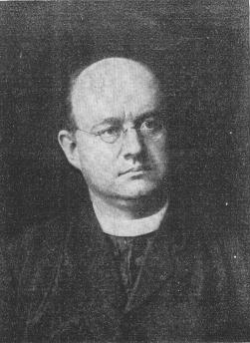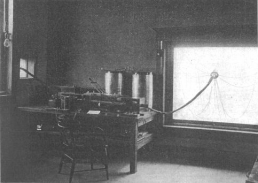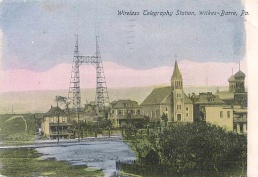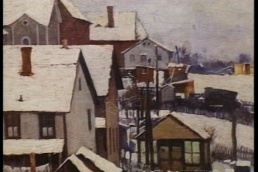Jozef Murgaš
 Murgaš in c1906.[1] | |
| Born |
February 17, 1864 Tajov-Jabríková (Tajó), Kingdom of Hungary, Austrian Empire |
|---|---|
| Died |
May 11, 1929 (aged 65) Wilkes-Barre, Pennsylvania, United States |
Jozef Murgaš (Joseph Murgas) was an inventor, painter, architect, botanist, patriot, and Roman Catholic priest. He contributed to wireless telegraphy and helped to develop mobile communications and wireless transmission of information and voice. Murgaš was nicknamed the Radio Priest and deemed a Renaissance man.
Contents
Early life
Murgaš was born in Tajov (Tajó), Kingdom of Hungary, Austrian Empire (now Slovakia). Parents: Ján Murgaš and Zuzana (born Slamová). Since his youth he was bright, skillful and good at painting and electrotechnology. He attended grammar school in Tajov and high school in Banská Bystrica (1876–80), attending there a painting atelier of Jozef Božetech Klemens who noticed his talent and also introduced him to Dominik Skutecký. His parents were unable to further finance his studies leaving him with the choice of becoming a priest. He studied theology in Prešporok (now Bratislava) (1880–82) and Esztergom (1882–84). The vice-head of the school in Esztergom allowed him to use the physics room for experiments where Murgaš first comes in contact with tools for demonstrating electrical phenomena.
Studies in Budapest and Munich (1889-93)
After priestly ordination in 1888, Murgaš worked as a curate in Dubová. On Skutecký's initiative, Murgaš was accepted at a painting school in Budapest, where he studied from 1889–90. He also studied painting in Munich from 1890-93. He attended both schools while working. He painted sacral pieces, landscapes and personalities.
Religious service (1893-96)
It was due to his strong patriotism he exhibited during his visit of the bishop during holidays in 1893 (including his critical review of Munkacsy's painting Honfogalas) that he was not allowed to finish his painting studies and had to work as a curate at changing locations in the Kingdom of Hungary: Chrenovec (Nyitratormás), Slovenská Ľupča (Zólyomlipcse), Dubová (Cseres) and Lopej (Lopér). He created a sacral painting at each of these churches. In Lopej, he painted a large sacral picture of St. George, which is still on the church altar of the village. The central altar painting of St. Elisabeth, in the 14th century Church of St. Elizabeth in the main square of Banská Bystrica, is also his work.
Wireless telegraphy experiments in the United States (1896-1920)

Due to permanent conflicts with the bishop's secretary and being accused of "panslavism", Murgaš replied to the call for a priest for a Slovak parish in newly founded mining city of Wilkes-Barre, Pennsylvania, counting 65 Slovak families. Murgaš emigrated in April 1896. Having no possibility to paint, besides his numerous communal activities he started to deal with natural sciences again, especially electrotechnology. His article "Telegrafovanie bez drôtu" in Tovaryšstvo magazine of 1900 (his only article published in Slovakia) shows that his radiotelegraphy studies had achieved a high level, "Nič neni snáď čudnejsieho a tajomstva plnšieho medzi vynálezmi v odbore elektrickom jako telegrafovanie bez drôtu. Práve preto myslím, že nebude od veci napísať krátke vysvetlenie vážneho tohto vynálezu, nakoľko som to vstave učiniť a nakoľko som sa o tom vlastnými experimentami presvedčil."
After Heinrich Hertz (1888) satisfactory demonstrated the existence of electromagnetic waves earlier theorised by Maxwell, Nikola Tesla demonstrated electromagnetic wave transmission on his lecture tour in Europe and the States (1890s), and Alexander Stepanovič Popov demonstrated wireless signal transmission over a distance of 250 m (1895, 5 km in 1897, 46 km in 1899), Guglielmo Marconi registered a patent for wireless telegraphy in England in 1896 based upon Popov's device and started a company for wireless telegraphy (in 1902 achieving radio connection across the Atlantic). Murgaš was aware of the importance of these developments and started working on their improvements. Unlike Marconi who used two different signal durations for dot and dash, he worked with two different signal frequencies of the same duration, making transmission faster and more reliable. On 2nd October 1903 he declared his first patent in Washington and on 10th May 1904, received the rights for two key patents by the Patent Office in Washington: the Wireless-Telegraph Apparatus (adaptation of a Wahnelt type interrupter and construction of an electromagnetic waves detector, in which a rotating carbon lug replaces a coherer with metallic swarf) and Method of Communicating Intelligence by Wireless Telegraphy (tone system for the transmission of Morse code signs, substituting the "dot" with a higher tone and the "dash" with a lower tone).
Following the first two patents, he created the Universal Ether Telegraph Co. based in Philadelphia. He established a laboratory in Wilkes-Barre to primarily investigate radiotelegraphy, and erected a 60-metre high antenna mast. His lab was visited by President Theodore Roosevelt in August 1905 (after his speech at Father Matthew Society in Scranton, PA) and was given a special demonstration of the system. It was the first time Roosevelt witnessed such a phenomenon, Murgaš was highly complimented and encouraged with a promise of government support [1]. Universal Ether Telegraph organized a public test of Murgaš's transmitting and receiving facilities in early August 1905, achieving radio transmission between Wilkes-Barre and Scranton, Pennsylvania, having their mayors Kirkendall and Connelly talk to each other over a distance of 20 miles (30 km) at the rate of fifty words per minute, and even received a confirmation receipt about successful connection to Brooklyn, 200 km away. The test was successful, the first message sent was "Thank God for His blessings."[3] However a storm destroyed the antenna mast in Scranton three months later, followed by deaths of two of the company co-founders, which led to dissolution of the company in 1906.
After successful experiments with underground wireless telegraphy over several miles, in 1906 Murgaš planned to establish transatlantic connection between 3000-feet deep shafts, one in the States and one in Europe. Each shaft was to be walled with concrete to guard it from dampness; and wires leading some distance into the earth from the shafts were to be incased in iron or steel tubing. The system would require high power to generate the transmitting waves; and Murgaš would use his own signal system (rather than Morse code which was then norm), with musical tones, each indicating a letter of the alphabet in the code word or group of words, and thus giving greater rapidity of operation than the Morse system.[4] Although Murgaš obtained some financial backing from the Universal Ether Telegraph, his system never went into commercial operation.[2]
Thomas Edison paid remarkable attention to Murgaš' experiments and he is said to have informed Marconi of Murgaš' success. Marconi then visited his lab in November 1905 [3], received an explanation of the apparatus from Murgaš, and developed his Tone System into what he called Sonorous-System.
Further 15 patents followed between 1907 and 1916, including a patent on wave meter (1907), electrical transformer (1907), magnetic waves generator (1908), wireless telegraphy (1909), magnetic waves detector (1909), generator of electrical oscillations (1911 and 1916), or spinning reel for fishing rod (1912).
Interior of transmission and receiving station, Wilkes-Barre, 1905.[5]
Receiving apparatus, 1905.[6]
Details of receiving-R-wave detector, taken to pieces. R1-wave detector, set up. D-cover, S-steel shaft, P-pulley, B-nut for clamping needle, N-needle, C-carbon, PL-support, coated with platinum. 1905.[7]
Towers in Wilkes-Barre, 1905.[8]
Towers in Wilkes-Barre, 1905.[9]
Communal activities in the US
Murgaš's primary concern in Wilkes-Barre, however, were the local Slovaks. He took care of Slovak immigrants, had a new church, library, cemetery, several schools, gymnasium and playgrounds built, all of which are still used today. In 1911, together with thirty-eight Slovak priests, he founded the Slovak Catholic Federation [4]. He was also one of the founders of the Saints Cyril and Methodius community and took care of children and youth. He founded a cultural and religious weekly Katolík, and with Jozef Joščák published an illustrated entertainment magazine Šašek. Murgaš was active in the Slovak expatriates movement, wrote articles for their press, was one of the founders of the Slovak League in America, actively supported the creation of the state of Czechoslovakia, organized a fund of American Slovaks for the creation of Czechoslovakia (1,000,000 USD). He was one of the signatories of the Pittsburgh Agreement (1918) between Czechs and Slovaks on establishing Czechoslovakia [5]. As a respected personality, he gained trust and support of the highest authorities in the USA for the establishment of Czechoslovakia.
Later life
When the United States entered World War I (1917), private radio telegraphy stations were banned, which put an end to Murgaš' pioneering work in this field. He continued to study physics and to do many experiments, and he also returned to painting. He financed his activities by selling his paintings. He also collected mushrooms, plants, minerals and insects. His butterfly collection comprised 9000 pieces from all over the world (destroyed by vandals along with his laboratory few hours after his death).
Murgaš promised Masaryk to visit newly founded Czechoslovakia, which he did in 1920 (Masaryk was too busy to receive him then). He wished to teach electrotechnology but was declined a permit from the Ministry of Education in Prague due to insufficient qualification (and proposed him instead to serve as bishop of Czechoslovak Church). He returned to Wilkes-Barre four months later. He was nominated to be a member of the Federal Radio Commission of the United States in 1925 which Murgaš declined due to health problems. He died in Wilkes-Barre after a heart attack four years later.
Notes
Literature
- Articles by Murgaš
- "Telegrafovanie bez drôtu", Tovaryšstvo 3 (1900), Ružomberok, p 247. (Slovak)
- "Von s farbou!", Americkoslovenské noviny, 2 January 1901 and 17 January 1901. (Slovak)
- Murgas, Joseph (8 December 1905). "The Murgas System of Wireless Telegraphy". Electrical Review: 849-852.
- "Slnce", Jednota, catholic calendar, Cleveland, 1911. (Slovak)
- New Yorkčan (pseud.), "Na pomoc Slovensku", Newyorský denník VII (1920), No 2121-2124. (Slovak)
- "Z mojich skúseností", Newyorský denník VII (1920), No 2124-2130. (Slovak)
- "Rev. Murgaš odpovedá Jehličkovi", Newyorský denník VII (1920), No 2131. (Slovak)
- "Reverend Jozef Murgaš - autobiografia", Newyorský denník XVI (1929), No 4749-4750. (Slovak)
- polemics, Newyorský denník VII (1920), No 2138-2140, 2144, 2148-2151, 2153-2155, 2157, 2159, 2168, 2172, 2174, 2178. (Slovak)
- Books on Murgaš
- Paličkár, Štefan (1950). Rev. Joseph Murgaš: Priest – Scientist. His Musical Wireless Telegraphy and The First Radio. New York: Teodor Juraj Kojiš. pp. 179. [6] [7]
- Voda, Juraj (1955). Jozef Murgaš: priekopník rádiotelegrafie. Martin: Osveta. pp. 120 (Slovak).
- Vranka, Jozef (2004). Z doliny prerástol hory: Jozef Murgaš: kňaz, maliar, vedec, vynálezca. Bratislava: Arimes. pp. 280 (Slovak). [8]
- Articles on Murgaš
- F.R. Osvald, "Naši vzdelaní mužovia v cudzine", Literárne listy 8 (1898), pp 3-4. (Slovak)
- "Telegraphy by Music". The Saint Paul Globe: 31. 12 June 1904. Transcript.
- "The Murgas System of Wireless Telegraphy". Electrical World and Engineer: 100-101. 11 July 1905a.
- "Note about the Murgas Wireless System". Electrical World and Engineer: 212. 5 August 1905b.
- "Underground Wireless Telegraphy". Technical World: 326-327. May 1906a.
- "Životopis Jozefa Murgaša", Slovenské ľudové besedy II (1906), No 1, Ružomberok. (Slovak)
- "Rev. Jozef Murgaš a telefonovanie bez drôtu", Newyorský denník VII (1920), No 2064. (Slovak)
- Jozef Joščák, "Jozef Murgaš, ako som ho ja poznal", Newyorský denník XVI (1929), No 4759, 4764, 4770. (Slovak)
- Rudolf Štechmiler, Václav Hach, Průkopníci naší techniky, SNDK, Prague, 1945. (Czech)
- Janko Alexy, Osudy slovenských výtvarníkov, Bratislava, 1948. (Slovak)
- Václav Gutwirth, "Jozef Murgaš, zapomenutý slovenský vynálezce", Práce a vynálezy VII, 1948, No 4-5, Prague. (Czech)
- Václav Gutwirth, Z dětství naši elektrotechniky, SNTL, Prague, 1953. (Czech)
- Rudolf Štechmiler, "Aký bol Jozef Murgaš", Technické noviny II (1954), No 4, Bratislava.
- Rudolf Štechmiler, "Jozef Murgaš", Technické noviny (1954), Bratislava.
- Rudolf Štechmiler, "Jozef Murgaš", Věda a technika mládeži (1954), No 10, Prague.
- Rudolf Štechmiler, "Slovenský průkopník bezdrátové telegrafie", Amatérské rádio III (1954), No 7, Prague. (Czech)
- Rudolf Štechmiler, Živá minulost naší techniky, Mladá fronta, Prague, 1954. (Czech)
- Juraj Voda, "Jozef Murgaš - slovenský priekopník rádiotelegrafie", Naša veda I (1954), No 5, Bratislava. (Slovak)
- Ondřej Póss, "Jozef Murgaš", Pokroky matematiky, fyziky a astronomie, Vol. 25 (1980), No. 2, pp 61-65. (Slovak)
- J. Tibenský, et al, Priekopníci vedy a techniky na Slovensku 2, Bratislava, 1988, pp 791-798. (Slovak)
- Theatre play on Murgaš







